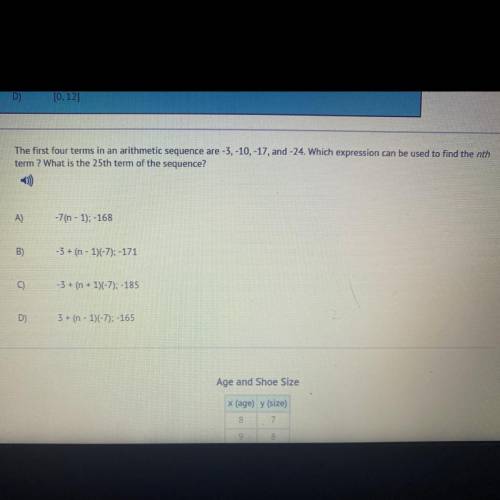
Mathematics, 06.11.2020 14:00 Shaynele
The first four terms in an arithmetic sequence are -3,-10,-17 and -24.which expression can be used to find the nth term? what is the 25th term of the sequence
A).-7(n-1);-168
B).-3+(n-1)(-7);-171
C).-3+(n-1)(-7);-185
D).3+(n-1)(-7);-165


Answers: 1


Another question on Mathematics

Mathematics, 21.06.2019 18:00
Agroup of students want to create a garden. they do not know the exact measurements but they propose using a variable to represent the length and width of the garden. the length of the garden is 10 feet longer than double the width. use a single variable to write algebraic expressions for both the length and width of the garden. write an algebraic expression for the area of the garden. use mathematical terms to describe this expression.
Answers: 3

Mathematics, 21.06.2019 21:30
A.s.a.! similarity in right triangles, refer to the figure to complete this proportionc/a = a/? a.) cb.) hc.) rd.) s
Answers: 1

Mathematics, 22.06.2019 01:30
Pllz me also i will report if you are in for the 1. complete the table by converting each decimal to a fraction. repeating decimals. 0.31 0.125 0.1607 2. describe any patterns you noticed when converting the decimals in the table above.
Answers: 1

Mathematics, 22.06.2019 02:00
Study published in the journal of personality and individual differences found that adults with adhd displayed more creative achievement than those who didn't have the disorder. "for the same reason that adhd might create problems, like distraction, it can also allow an openness to new ideas," says holly white, assistant professor of cognitive psychology. "not being completely focused on a task lets the mind make associations that might not have happened otherwise." white and priti shah at the university of michigan gave 60 college students – half of them with adhd – a series of tests measuring creativity across 10 domains. the adhd group scored higher across the board. the adhd group showed more of a preference for brainstorming and generating ideas than the non-adhd group, which preferred refining and clarifying ideas. the adhd status of the participants was established by asking whether the individual had ever been clinically diagnosed with adhd/add. the tests of creativity were pencil-and-paper tasks administered in a laboratory setting. each of the ten scales was comprised of multiple questions, the scores on which were summed (e.g., writing creativity: "how many words can you make from the letters in the word 'psychology' invention creativity: "write down as many uses for a paper clip that you can think of.") this procedure does allow for a participant to be scored as showing no creativity under these conditions. a) state the research question in plain language (i wonder if is related to (1 point) b) state the null hypothesis (1 point) c) state the research hypothesis (1 point) d) is the research hypothesis directional or non-directional (1 point) e) name the predictor / independent variable f) give the operational definition of the predictor / independent variable g) evaluate the construct validity of the predictor / independent variable. (face, procedure, method-match) h) name the outcome / dependent variable i) give the operational definition of the outcome / dependent variable. j) evaluate the construct validity of the outcome / dependent variable. (face, procedure, method-match)
Answers: 1
You know the right answer?
The first four terms in an arithmetic sequence are -3,-10,-17 and -24.which expression can be used t...
Questions



Mathematics, 23.04.2021 23:00






Mathematics, 23.04.2021 23:00


Mathematics, 23.04.2021 23:00


Mathematics, 23.04.2021 23:00



Mathematics, 23.04.2021 23:00


Social Studies, 23.04.2021 23:00

Mathematics, 23.04.2021 23:00

Mathematics, 23.04.2021 23:00



